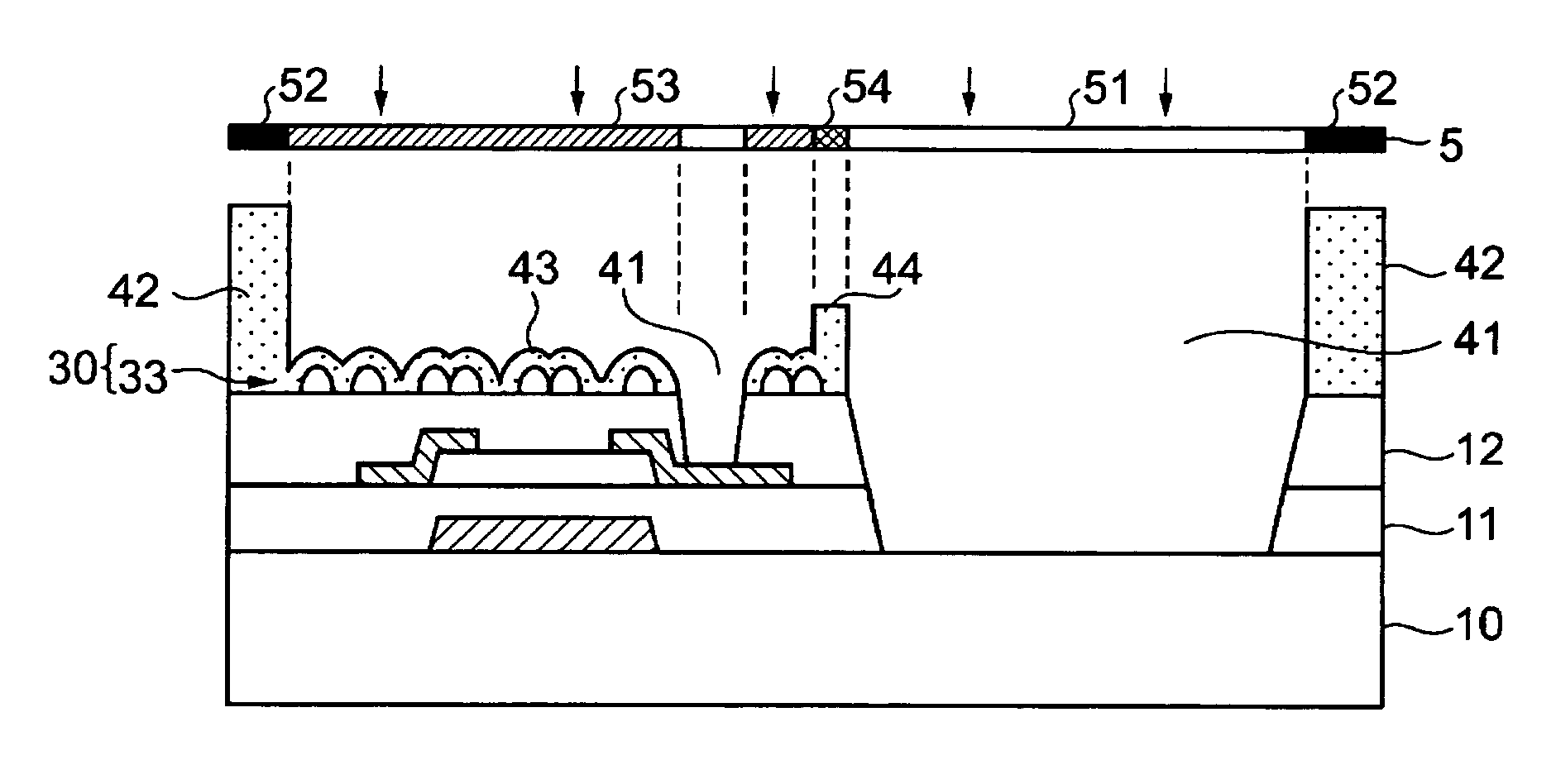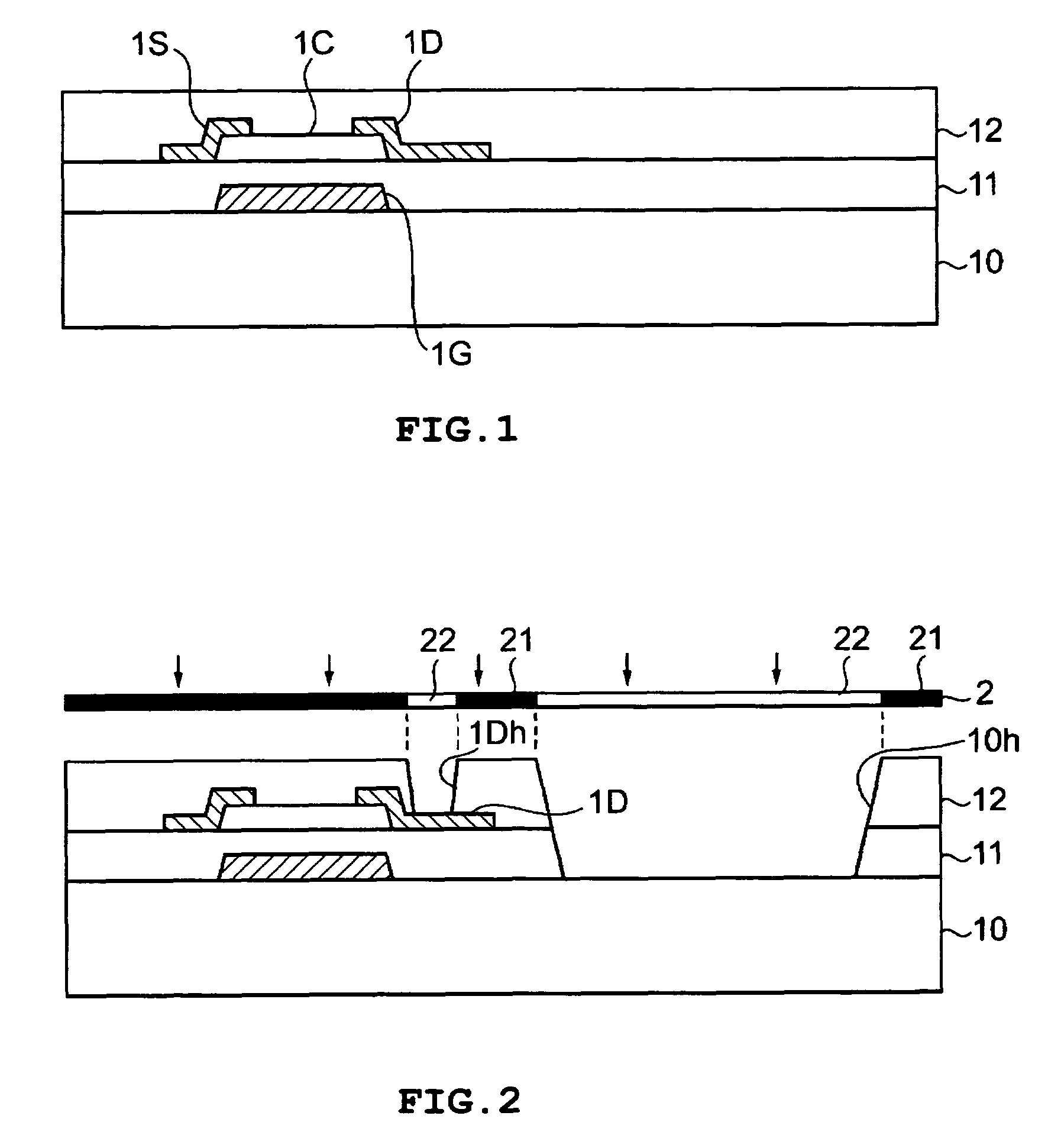Color filter structure and display device using the color filter, and manufacturing method thereof
a color filter and structure technology, applied in the field of color filter structure and display device using the color filter, can solve the problems of not giving any consideration for simplifying a manufacturing process from aspects such as actual cost and yield or the like, and the quality degradation of display colors in a whole screen area, so as to reduce the difference in the coloring effect of light, reduce the cell gap, and reduce the effect of cell gap
- Summary
- Abstract
- Description
- Claims
- Application Information
AI Technical Summary
Benefits of technology
Problems solved by technology
Method used
Image
Examples
first embodiment
[0056]In FIG. 1, there is shown a structure of a composite layer including a TFT (thin film transistor) that is a pixel drive element of a liquid crystal display device. In order to form this structure, first, a glass substrate 10 serving as a substrate is prepared. After required treatment such as washing has been carried out, a metal material such as aluminum is deposited on the substrate, and is patterned to form a gate electrode 1G of the TFT and a gate bus line (not shown) connected thereto. The gate electrode 1G is formed here on a pixel-by-pixel basis. After these gate-associated portions have been formed, an electrical insulation material such as SiNx is deposited fully on the substrate to form a first insulation layer 11. On the insulation layer 11, amorphous silicon (a-Si) serving as a semiconductor material and phosphor (P)-doped amorphous silicon each are deposited in order and are patterned to form a semiconductor layer 1C. The semiconductor layer 1C is formed in a shap...
second embodiment
[0085]Now, another embodiment of the present invention will be described with reference to FIG. 12 to FIG. 15.
[0086]In the present embodiment, masking and exposure treatments as shown in FIG. 12 are carried out after the steps corresponding to FIG. 1 to FIG. 4 in the above described embodiment have been carried out similarly in general. While a mask 5A shown in FIG. 12 is defined as a half-tone mask, this mask is patterned according to five types of portions in this embodiment. A difference from the case of FIG. 5 is that a fifth portion 55 having a transmission rate between a fourth portion 54 and a second portion 52 (about 10% in this embodiment) is provided between a second portion 52 and a third portion 53. The fifth portion 55 is indicated by a white dot on a black base in the figure. In addition, although it cannot be read from FIG. 12, an organic material 4 deposited before masking is defined to be higher than that shown in FIG. 4. This is because a photo spacer described lat...
third embodiment
[0092]Now, still another embodiment of the present invention will be described with reference to FIG. 16 and FIG. 17.
[0093]In the present embodiment, after the steps corresponding to FIG. 1 to FIG. 4 in the first embodiment have been carried out similarly in general, masking and exposure treatments as shown in FIG. 16 are carried out. Although a mask 5B shown in FIG. 16 is defined as a half-tone mask, this mask is patterned according to three types of portions in this embodiment. A difference from the case of FIG. 5 is that a fourth portion 54 is not provided and that only first to third portions 51 to 53 are provided.
[0094]After exposure treatment has been carried out using such a photo mask 5B, when developing treatment and fixing treatment are done, there are formed: a portion 41 corresponding to a first portion 51 of the photo mask 5B; a portion 42 corresponding to a portion 52 thereof; and a portion 43 corresponding to a portion 53 thereof. The portion 41 is provided as a porti...
PUM
| Property | Measurement | Unit |
|---|---|---|
| height | aaaaa | aaaaa |
| light transmission | aaaaa | aaaaa |
| color | aaaaa | aaaaa |
Abstract
Description
Claims
Application Information
 Login to View More
Login to View More - R&D
- Intellectual Property
- Life Sciences
- Materials
- Tech Scout
- Unparalleled Data Quality
- Higher Quality Content
- 60% Fewer Hallucinations
Browse by: Latest US Patents, China's latest patents, Technical Efficacy Thesaurus, Application Domain, Technology Topic, Popular Technical Reports.
© 2025 PatSnap. All rights reserved.Legal|Privacy policy|Modern Slavery Act Transparency Statement|Sitemap|About US| Contact US: help@patsnap.com



